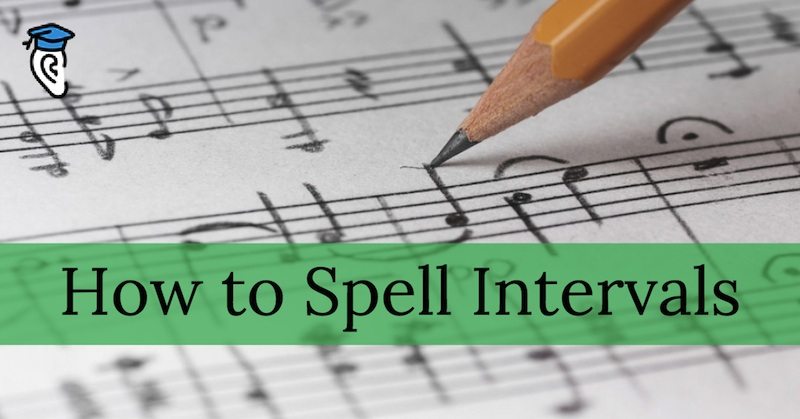You may have heard other musicians chatting about seconds, thirds, or perfect fourths. What are they talking about? Well, they aren’t chatting about having a second helping of mashed potatoes or about a super confusing game of baseball. They are talking about intervals.
Intervals unlock a range of exciting musical skills when you learn to recognise them, but don’t overlook the other important part of learning intervals: Learning how to spell intervals.
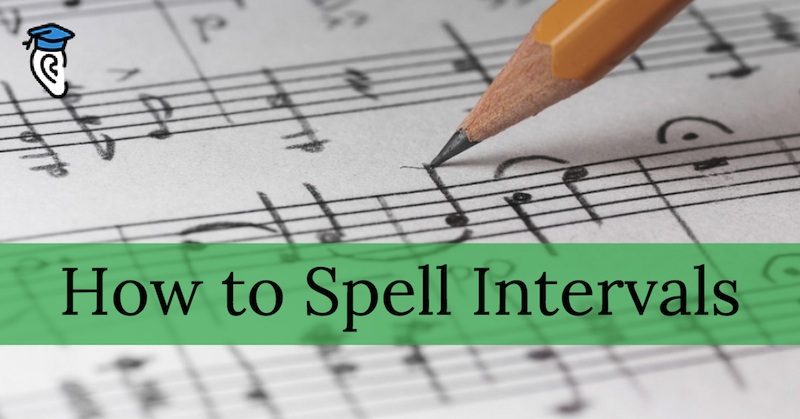
What is an Interval?
When you play two different pitches, say a C and a G, the difference between these two notes is called an interval. Musicians have been using intervals in western music for centuries. In fact, before chords were commonplace, musicians determined which notes to play based on intervals, both based on mathematical and spiritual principles.
Believe it or not we owe much of our western music theory to guys in togas. The Greeks developed Pythagorean tuning, which is tuning based on ratios. This tuning found that ratios like a perfect fifth were consonant and practically perfect to the ear. Based on this, they developed scales based on intervals of the perfect fifth, coming up with twelve tones that we use today as the basis for our scales, with some tuning tweaks that came over time.
Why Should I Care About Intervals?
Learning intervals is an important tool for any musician, whether you are a vocalist, a saxophone player, guitarist, or keyboard player. Producers and songwriters can also learn a lot through intervals. When you know intervals and can identify them when you hear them, you can harmonize better, figure out melodies and riffs, and even dictate chord progressions. Professional drummers may tune their drums to specific intervals, like minor thirds, or even entire scales to match their band.
Interval training has two parts: learning to recognise the different intervals and learning how to “spell” them, meaning you know the corresponding notes on your instrument or the score. You can learn about recognising intervals in our Ultimate Guide to Intervals. Here we’ll cover the other side: how to spell intervals.
Let’s start with the basics.
Interval Qualities
Interval Names in C Major.
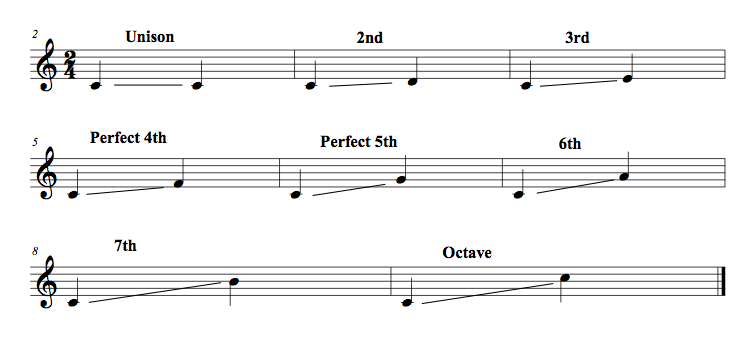
As you can see, there are many different types of intervals. Generally, people are referring to major intervals when they are talking about intervals. These are intervals you would find in the major scale without any altered pitches. For example, when someone is talking about a third up from C, they are talking about E.
Major 3rd
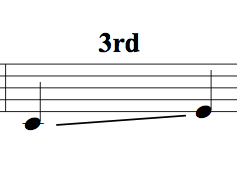
You might also have heard of minor, augmented, perfect, and diminished intervals. Intervals were given these names based on their consonance, or how pleasant they sound to the ear. Interestingly enough, many of the intervals that are acceptable today would have been considered painful to the ear centuries ago! And some intervals, like the tritone, or augmented fourth, were considered evil!
- Perfect Intervals – These refer to Perfect 4ths and 5ths, octaves, and unisons.
- Major Intervals – Intervals in the major scale.
- Minor Intervals – Lowered interval from the major scale (ex. C to E♭ instead of E is a Minor 3rd)
- Augmented Intervals – Perfect intervals that have a raised tone (ex. C to F♯ is an augmented 4th or tritone).
- Diminished Intervals – Perfect intervals that have a lowered tone (ex. C to G♭ is a diminished interval)
While there are many, many intervals, for this article we will stick with the intervals that you will most likely encounter in your daily musical practice. Remember you can apply interval training to any diatonic scale.
Interval Sizes
When you figure out an interval, you are simply counting by half steps. If you are looking at a piano keyboard, a half step is simply one key to the next. For example, if you play an F (a white key) and move to the next key up (F♯) you have moved one half step. If you move from F (a white key) to G (a white key) then you have moved a whole step. The same works if you move down a whole step from a G to a F (white key to white key), or move down a half step from F♯ (a black key) to F natural (a white key.
It’s easy to see this on a staff:

The first note is always number 1 when counting intervals. In our examples, we will use a C major scale and C will be the first note, or the tonic. You can also reverse the intervals. For example, C up to G or G down to C are both Perfect 5ths.
How to Spell Intervals
Now that you know the fundamental concepts behind the types of interval it’s time to learn to spell intervals. When we talk about “spelling” intervals we mean being able to do two things:
- Take a pair of notes (e.g. C and the G above it) and name the interval (in the example, a Perfect Fifth)
- Take a starting note and an interval (e.g. C and “Major Third ascending”) and name the ending note (in the example, E).
When you can do these two things it becomes easy to apply your interval recognition skills on your instrument or with written music, enabling you to compose, improvise and play by ear using interval recognition.
Begin by figuring out the intervals in the key of C Major where there aren’t any accidentals to worry about.
It’s easy to memorise all the perfect and major intervals in C major and then you know how to spell these types of interval starting or ending on a C note. You should be able to do the two tasks above for this set of intervals and notes.
You can then easily also figure out any minor, augmented and diminished intervals starting or ending on C by starting from the spellings you’ve memorised. For example when you know that a major third up from C is E, you also know that a minor third up from C is E♭.
One you’ve mastered one key, add another, such as F major or G major. In time you will build up your ability to instantly name the notes of an interval starting from any note, or to name the type of interval between two given notes.
It can take some time to master the full set of keys and intervals, so here’s another trick you can use to accelerate your learning:
Shortcut: Interval Inversions
As you learn the intervals, you might notice something interesting. For example, C up to G is a Perfect 5th. If you start at C and go down to G, then you have a Perfect 4th.
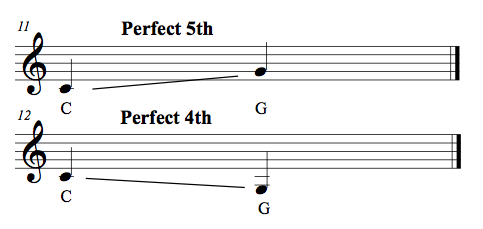
These pairs of intervals are called inversions. And it’s easy to figure these out:
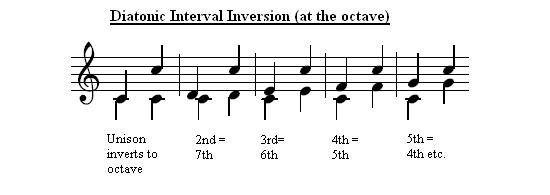
Unisons inverted become octaves. A second (e.g. C to D) becomes a 7th when inverted (e.g. D to C). A 3rd (e.g. C to E) when inverted becomes a 6th (e.g. E to C). Look at the inversions below and commit these pairs to memory and you can quickly shortcut learning how to name intervals:
- Unisons ←→ Octaves
- 2nds ←→ 7ths
- 3rds ←→ 6ths
- 4th ←→ 5th
- 5th ←→ 4th
- 6th ←→ 3rd
- 7th ←→ 2nd
The quality of the interval in an inversion pair changes like this:
- Perfect←→Perfect
- Major←→Minor
- Augmented←→Diminished
For example, a perfect 4th becomes a perfect 5th. A major 3rd becomes a minor 6th. An augmented 2nd becomes a diminished 7th. And so on.
Exercise 1: Spelling Intervals Practice
Let’s practice the first skill described above: take a pair of notes and name the interval. We’ll stick with C Major for now.
Instructions
- Look at the interval provided.
- Guess the interval name.
- Check your answers using the “Interval Names in C Major” image above.
Question 1:
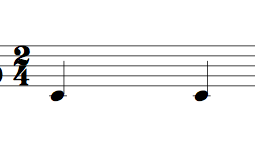
Question 2:
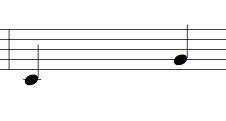
Question 3:
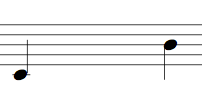
Question 4:
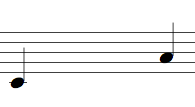
Exercise 2: Ultimate Interval Battle
Here’s a fun game you can use to help you memorise the interval spellings.
Make up a deck of cards for different intervals, each one listing the two notes of the interval along with the interval name. At first you might want to work on major and perfect intervals like the octave, then work up to minor, augmented, and diminished intervals. Start in C Major, then add in cards for other common scales like F major, G major or A minor to add variety.
- Stack the deck facedown on a table.
- Player 1 selects a card.
- Player 1 says what the two notes are on the card. (Ex. “C” and “E”).
- Player 2 tries to guess the interval (Ex. “Major third).
- If Player 2 is correct, they collect the card. If they do not guess the interval, the card goes to the bottom of the deck to be played again.
- Now Player 2 selects a card and says the notes on the card.
- Play continues until all the cards are gone. The player with the most cards wins.
For variations on the Ultimate Interval Battle, add in extra players, more intervals like augmented intervals, and scales. If you cover up half the card when you pick it up you can also use the deck to practice by yourself. Keep the cards with you so you can review them when you have a free moment, during your lunch break, or even when you are watching TV. Over time you will continue to add in cards and soon master interval spelling.
Learning to Spell Intervals
Be sure to practice intervals every day if you want to make consistent progress. Here are a few things that you can do to help learn intervals:
- Memorize the inversion charts.
- Practice spelling intervals at least ten minutes per day. Remember to add in new scales and interval types gradually.
- Practice Ultimate Interval Battle with a friend and use the cards to practice on your own at least a few times a week.
- Practice spelling intervals in different keys and scales.
- When you practice scales on your instrument, practice playing each of the intervals in the scale too, naming them in your head.
Learning to recognise the sounds of intervals is a valuable and powerful musical skill, but it can only take you so far. Memorise the spellings of intervals along with the tips and tricks above so that you can effortlessly spell any interval instantly, and you will unlock the power of intervals in written music and in your instrument playing too.

